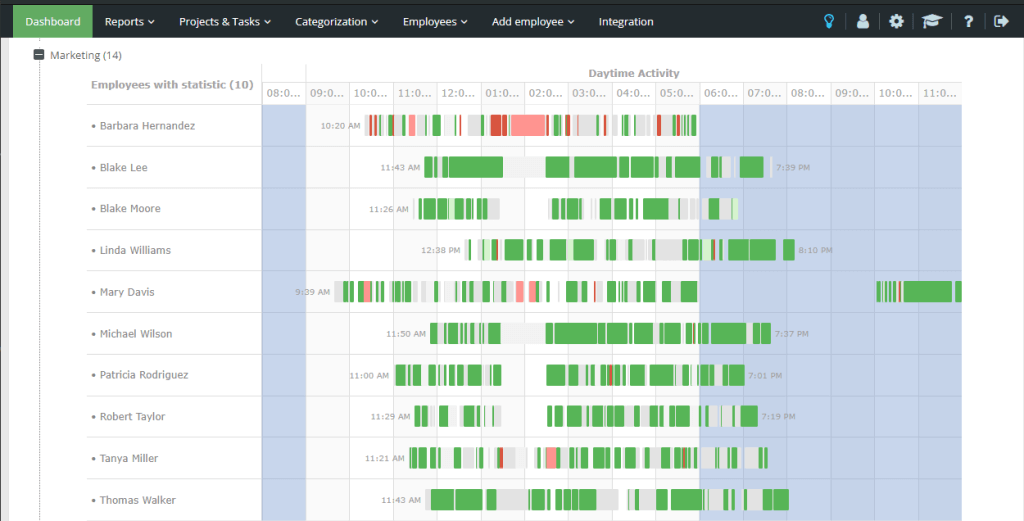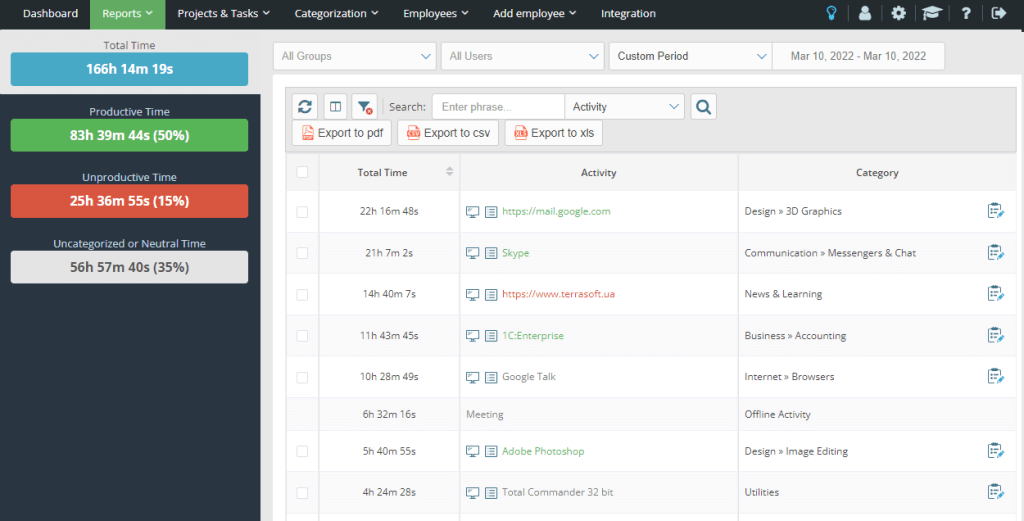If your team delivers – but your leadership doesn't see it, you've got a reporting problem, not a performance problem.
Converting your team's daily efforts into compelling evidence for executives requires more than standard status updates. This guide shows how to transform Yaware.TimeTracker data into credible reports that defend your team's performance, justify budgets, and build trust without micromanagement.
Why Proving Team Efficiency is Harder Than It Sounds
Remote and hybrid work creates significant visibility gaps between teams and leadership. When executives can't physically see work happening, they need stronger evidence of productivity and value.
The fundamental challenge is the mismatch between daily work activities and leadership's expectations. Your team may spend weeks on complex tasks with minimal visible output, while executives expect consistent, measurable progress.
Traditional reporting methods fail because they:
- Provide point-in-time snapshots without context
- Rely on subjective self-reporting
- Focus on completion status rather than work patterns
- Miss critical productivity factors like focus time quality
- Lack credible, objective measurement standards
These fundamental flaws create a disconnect between actual team performance and how it's perceived by leadership, making it essential to adopt more objective and comprehensive reporting solutions.
What a Good Report Needs to Actually Prove Efficiency
A report that convinces leadership needs specific elements beyond basic activity logs. Effective reports must balance detail with clarity while connecting time usage to business outcomes.
The transparency paradox is key: You need to show detailed work patterns without crossing into surveillance territory. According to Gallup, employees who feel fairly evaluated are 3.2 times more engaged, but this requires respecting professional autonomy.
Time allocation per task/project provides the foundation for credibility. This shows where efforts are focused and helps justify resource needs by demonstrating exactly how time translates to outcomes.
Focus vs. distraction metrics highlight productivity patterns and systemic issues. For example, excessive time in communication tools might indicate process inefficiencies that leadership can help address.
Trends over time, not just current performance snapshots, demonstrate sustained effort or improvement patterns. Week-over-week or month-over-month comparisons reveal the impact of new initiatives, seasonal variations, and overall team progress.
How Yaware.TimeTracker Turns Time Logs Into High-Trust Reports
Yaware.TimeTracker transforms automatic time tracking data into structured analytics that team leaders can use to demonstrate effectiveness with minimal effort.

Pre-set dashboards display the most relevant metrics for productivity, focus, and workload distribution. These ready-made views allow managers to generate leadership-facing reports in minutes rather than spending hours manually compiling data.
Real-time and historical insights provide both immediate performance visibility and long-term trends. This dual perspective is particularly valuable when proving the impact of process changes or new tool investments.
Project-level views connect time usage directly to business initiatives. By tagging and categorizing time, managers can show exactly how much effort goes into each strategic priority, making resource allocation discussions more objective.

The system is designed to explain value, not punish behavior. The focus on positive metrics and improvement trends helps create a culture of trust and continuous optimization instead of micromanagement.
Example: From Raw Logs to Exec-Ready Report
Here's how a marketing team uses Yaware.TimeTracker to create compelling leadership reports that protect their budget and resources.
Step 1: Data Collection
The system automatically captures time spent in applications, websites visited, focus duration, and breaks. These basic data points provide the foundation for deeper analysis.
Step 2: Organization with Tags and Categories
The team classifies their time by project, task type, and priority. For example, Photoshop time is tagged for specific campaign work, while Google Analytics time is categorized under performance analysis. This structure transforms raw data into meaningful business intelligence.
Step 3: Report Generation
For weekly and monthly reports, the manager uses Yaware TimeTracker's templates to automatically aggregate key metrics:
- Time distribution across projects and task types with visual graphs
- Productivity trends compared to previous periods
- Analysis of time spent in meetings versus focused work
- Identification of peak productivity hours and optimal work patterns
These comprehensive metrics transform abstract work patterns into concrete data points that executives can immediately understand, creating a bridge between daily team activities and business outcomes that matter to leadership.
Step 4: Executive Presentation
When presenting to leadership, the manager doesn't just show that the team was “busy” but demonstrates specific results backed by objective data. This shifts the conversation from subjective evaluations to constructive, fact-based analysis.
Five Key Factors That Make Leadership Reports Effective
Proving team efficiency to leadership is both a technical and communication challenge. Before creating a report from Yaware.TimeTracker data, consider these key factors that determine its persuasiveness and impact.
Understanding these elements helps transform raw numbers into a powerful tool for defending your team's interests and resource needs.
- Business goal alignment. The most effective reports show progress toward specific business outcomes, not just activity. Demonstrate how your team's time allocation directly relates to company priorities and strategic initiatives.
- Data contextualization. Time metrics alone have limited value. Effective reports provide context through comparisons with previous periods, industry standards, or planned targets.
- Balance of detail and summary. Excessive detail can obscure important trends, while overly general reports lack evidence. Find the sweet spot that matches your audience's information needs.
- Proactive problem identification. Powerful reports don't just showcase successes but honestly highlight improvement areas. Identifying issues before leadership points them out builds credibility for your analysis.
- Solution orientation. Effective reports conclude with specific recommendations for process optimization, resource reallocation, or priority adjustments to improve productivity.
Considering these five factors transforms a standard time usage report into a strategic communication tool that protects your team's interests and builds your reputation as an effective manager.
Build Trust With Data, Not Pressure
Modern business demands transparency and objectivity, and Yaware.TimeTracker provides a powerful tool to meet these needs. Instead of spending hours manually compiling reports or relying on subjective assessments, you can automate data collection and focus on interpretation and strategic application.
Yaware.TimeTracker helps you advocate for your team when it comes to budgeting, staffing planning, or performance evaluation. You gain the ability to defend your team against unfounded productivity doubts by supporting your position with concrete, objective data.
Start using Yaware.TimeTracker today and generate your first transparent report — no micromanagement, just clarity. Register now and get access to an executive performance report template that will help you effectively communicate your team's value.
FAQ
How do I convince my team that time tracking protects their interests rather than enabling micromanagement?
Open communication is essential for successful Yaware.TimeTracker implementation. Explain to your team that the system provides objective evidence of their work and protects against subjective evaluations. Emphasize that data will be used to demonstrate their value to leadership, optimize workflows, and ensure fair resource allocation.
Involve the team in data analysis so they see practical benefits and can contribute implementation suggestions. Focus on how tracking helps them get credit for their actual work rather than appearing as a control mechanism.
Which metrics are most convincing when justifying additional budget to leadership?
The most persuasive metrics directly link time usage to financial outcomes or strategic company goals. Consider showing the ratio of time spent to revenue by project, time required for key business processes, or comparative productivity analysis at different resource levels.
Effectively demonstrate potential losses from team overload or insufficient funding, supporting this with data on work time distribution and focus levels. Always translate time data into business impact language that resonates with executive priorities.
How frequently should I generate leadership reports for maximum effectiveness?
Optimal reporting frequency depends on your company culture and business dynamics. Most organizations benefit from combining brief weekly overviews with detailed monthly reports.
Weekly reviews help quickly identify and address issues, while monthly reports allow analysis of long-term trends and systemic patterns. For critical projects or during organizational changes, more frequent analysis may be appropriate. Find a balance where reporting remains a productivity tool rather than becoming an end in itself.
What are common pitfalls when interpreting time tracking data?
When analyzing Yaware.TimeTracker data, avoid several common mistakes. First, don't equate time in “productive” applications with quality work—creative processes often require periods of “unproductive” thinking.
Second, don't directly compare specialists' productivity without considering their role differences. Third, avoid drawing conclusions from short-term data—reliable analysis requires sufficient time periods. Finally, never use data for punishment or criticism, only for constructive process improvement and team support.
How can I adapt Yaware.TimeTracker reports for different leadership levels?
Different leadership levels require varying detail levels and specific metric focus. For executive leadership, create brief, visually-oriented reports highlighting connections between time usage and strategic business goals. For middle management, include more details about resource distribution across projects and potential optimization areas. For project managers, provide detailed reports breaking down tasks, performers, and time trends.
Customize Yaware.TimeTracker report templates according to each audience's information needs to ensure maximum communication effectiveness.

